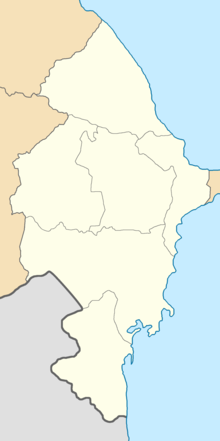Baku Governorate
Baku Governorate Бакинская губерния | |
|---|---|
Governorate | |
 Coat of arms | |
 Administrative map of the Baku Governorate (1905–1917) | |
| Country | Russian Empire |
| Viceroyalty | Caucasus |
| Established | 1846 |
| Abolished | 1920 |
| Capital | Baku |
| Area | |
| • Total | 37,948.97 km2 (14,652.18 sq mi) |
| Highest elevation | 4,466 m (14,652 ft) |
| Population (1916) | |
| • Total | 875,746 |
| • Density | 23/km2 (60/sq mi) |
| • Urban | 8.28% |
| • Rural | 91.72% |
Part of a series on the | ||||||||||||||||||||||||||||||||||||||||||||||||||||||||||||||||||||||||||||||||||||||||||
|---|---|---|---|---|---|---|---|---|---|---|---|---|---|---|---|---|---|---|---|---|---|---|---|---|---|---|---|---|---|---|---|---|---|---|---|---|---|---|---|---|---|---|---|---|---|---|---|---|---|---|---|---|---|---|---|---|---|---|---|---|---|---|---|---|---|---|---|---|---|---|---|---|---|---|---|---|---|---|---|---|---|---|---|---|---|---|---|---|---|---|
| History of Azerbaijan | ||||||||||||||||||||||||||||||||||||||||||||||||||||||||||||||||||||||||||||||||||||||||||
 | ||||||||||||||||||||||||||||||||||||||||||||||||||||||||||||||||||||||||||||||||||||||||||
| Stone Age • Bronze Age • Iron Age
| ||||||||||||||||||||||||||||||||||||||||||||||||||||||||||||||||||||||||||||||||||||||||||
| Antiquity
| ||||||||||||||||||||||||||||||||||||||||||||||||||||||||||||||||||||||||||||||||||||||||||
| ||||||||||||||||||||||||||||||||||||||||||||||||||||||||||||||||||||||||||||||||||||||||||
| ||||||||||||||||||||||||||||||||||||||||||||||||||||||||||||||||||||||||||||||||||||||||||
| ||||||||||||||||||||||||||||||||||||||||||||||||||||||||||||||||||||||||||||||||||||||||||
| ||||||||||||||||||||||||||||||||||||||||||||||||||||||||||||||||||||||||||||||||||||||||||
| ||||||||||||||||||||||||||||||||||||||||||||||||||||||||||||||||||||||||||||||||||||||||||
 Azerbaijan portal Azerbaijan portal | ||||||||||||||||||||||||||||||||||||||||||||||||||||||||||||||||||||||||||||||||||||||||||
|
The Baku Governorate,[a] known before 1859 as the Shemakha Governorate,[b] was a province (guberniya) of the Caucasus Viceroyalty of the Russian Empire, with its center in the booming metropolis and Caspian Sea port of Baku. Area (1897): 34,400 sq. versts, population (1897): 789,659.[2] The Baku Governorate bordered Persia to the south, the Elizavetpol Governorate (the Tiflis and Erivan governorates before 1868) to the west, the Dagestan Oblast to the north, and the Baku gradonachalstvo to the east on the Absheron Peninsula.
History
The governorate was originally established in 1846 as the Shemakha Governorate, replacing what had been several military precincts. Following the catastrophic 1859 Shamakhi earthquake, the capital of the governorate was transferred from Shamakha (Shаmakhi) to the fast-growing city of Baku, and on July 12, 1859, the governorate's name was changed accordingly. The coat of arms of the Baku Governorate was instituted on July 5, 1878.[3] Initially, the Baku Governorate included the areas of the former khanates of Karabakh and Shaki until these areas were detached in 1868 to form part of the adjacent Elizavetpol Governorate.
The Armenians were dominant in the commerce of the Baku Governorate as evidenced by them controlling 29% of enterprises in the province as opposed to the Azerbaijanis owning only 18%. Whilst Armenians enjoyed more favourable treatment under the Russian administration and produced oil tycoons such as Alexander Mantashev, Azerbaijanis made up most of the unskilled low-paid labor jobs and were virtually absent from the administration of the province despite their preponderance. In the early 20th century, Russian official Grigory Golitsyn increased the number of Azerbaijanis in the administration and confiscated properties of the Armenian Apostolic Church, however, his anti-Armenian policies (which provoked the Armenian–Tatar clashes) were later repealed in 1905 under the rule of Illarion Vorontsov-Dashkov.[4]
Upon the establishment of the Azerbaijan Democratic Republic, the Baku Governorate was incorporated into the fledgling state and subsequently separated into a smaller Baku General-Governorate and a Lenkoran General-Governorate, the latter being the location of the Provisional Military Dictatorship of Mughan which was suppressed in spring 1919. The governorate was eventually abolished in its entirety following the establishment of Soviet rule in Azerbaijan in 1920, however, its uezds ("counties") continued to exist until their administrative reorganization into raions ("districts") in 1929–1930.
Administrative divisions
The counties (uezds) of the Baku Governorate in 1917 were as follows:[5][6]
| Name | Administrative centre | Population | Area | |
|---|---|---|---|---|
| 1897 | 1916 | |||
| Baku uezd (Бакинский уезд) | Baku | 182,897 | 16,268 | 2,610.22 square versts (2,970.59 km2; 1,146.95 sq mi) |
| Geokchay uezd (Геокчайский уезд) | Geokchay (Goychay) | 117,705 | 134,098 | 4,676.58 square versts (5,322.24 km2; 2,054.93 sq mi) |
| Javad uezd (Джеватский уезд) | Salyan | 90,043 | 162,305 | 8,396.97 square versts (9,556.27 km2; 3,689.70 sq mi) |
| Kuba uezd (Кубинский уезд) | Kuba (Quba) | 183,242 | 198,204 | 6,308.61 square versts (7,179.59 km2; 2,772.06 sq mi) |
| Lenkoran uezd (Ленкоранский уезд) | Lenkoran (Lankaran) | 130,987 | 203,319 | 4,726.88 square versts (5,379.48 km2; 2,077.03 sq mi) |
| Shemakha uezd (Шемахинский уезд) | Shemakha (Shamakhi) | 121,842 | 161,552 | 6,625.99 square versts (7,540.79 km2; 2,911.51 sq mi) |
Demographics
The ethnic group composition of the governorate changed considerably in the latter part of the 19th century. By the beginning of the 20th century, there were 214,700 inhabitants, amongst them, Russians, Ukrainians and Belarusians consisting of 76.3 thousand (35.5%), Tatars 46 thousand (21.4%), Armenians 42 thousand (19.4%), Persians 25 thousand (11.7%), Jews 9.7 thousand (4.5%), Georgians 4 thousand (1.9%), Germans 3.3 thousand (1.5%), and Kazan Tatars 2.3 thousand (1.1%).[7] Muslims generally lived in the historical centre of Baku (Old Baku), surrounded by the khan's castle in the west of the city. Armenians mostly lived in the industrial zone in the north of the city. During the construction of the new city centre, various ethnic groups started to move to different districts.[8]
Russian Empire Census
According to the Russian Empire Census, the Baku Governorate had a population of 826,716 on 28 January [O.S. 15 January] 1897, including 458,065 men and 368,651 women. The majority of the population indicated Tatar[c] to be their mother tongue, with significant Tat, Russian, Armenian, Kyurin, and Talysh speaking minorities.[5]
| Language | Native speakers | % |
|---|---|---|
| Tatar[c] | 485,146 | 58.68 |
| Tat | 89,519 | 10.83 |
| Russian | 73,632 | 8.91 |
| Armenian | 52,233 | 6.32 |
| Kyurin | 48,192 | 5.83 |
| Talysh | 34,994 | 4.23 |
| Kazi-Kumukh | 11,811 | 1.43 |
| Jewish | 8,172 | 0.99 |
| Persian | 5,973 | 0.72 |
| German | 3,430 | 0.41 |
| Ukrainian | 3,372 | 0.41 |
| Avar-Andean | 2,898 | 0.35 |
| Georgian | 1,616 | 0.20 |
| Polish | 1,439 | 0.17 |
| Turkish | 1,155 | 0.14 |
| Belarusian | 677 | 0.08 |
| Mordovian | 531 | 0.06 |
| Swedish | 347 | 0.04 |
| Greek | 278 | 0.03 |
| Lithuanian | 272 | 0.03 |
| Other | 1,029 | 0.12 |
| TOTAL | 826,716 | 100.00 |
| Faith | Male | Female | Both | |
|---|---|---|---|---|
| Number | % | |||
| Muslim | 372,770 | 303,473 | 676,243 | 81.80 |
| Eastern Orthodox | 32,164 | 23,926 | 56,090 | 6.78 |
| Armenian Apostolic | 31,403 | 21,160 | 52,563 | 6.36 |
| Old Believer | 11,075 | 10,837 | 21,912 | 2.65 |
| Judaism | 6,599 | 6,154 | 12,753 | 1.54 |
| Lutheran | 1,911 | 1,869 | 3,780 | 0.46 |
| Roman Catholic | 1,574 | 644 | 2,218 | 0.27 |
| Baptist | 313 | 350 | 663 | 0.08 |
| Armenian Catholic | 96 | 109 | 205 | 0.02 |
| Reformed | 102 | 88 | 190 | 0.02 |
| Karaite | 3 | 5 | 8 | 0.00 |
| Anglican | 4 | 3 | 7 | 0.00 |
| Buddhist | 5 | 0 | 5 | 0.00 |
| Mennonite | 1 | 1 | 2 | 0.00 |
| Other Christian denomination | 42 | 31 | 73 | 0.01 |
| Other non-Christian denomination | 3 | 1 | 4 | 0.00 |
| TOTAL | 458,065 | 368,651 | 826,716 | 100.00 |
Kavkazskiy kalendar
According to the 1917 publication of Kavkazskiy kalendar, the Baku Governorate had a population of 875,746 on 14 January [O.S. 1 January] 1916, including 465,711 men and 410,035 women, 838,717 of whom were the permanent population, and 37,029 were temporary residents:[6]
| Nationality | Urban | Rural | TOTAL | |||
|---|---|---|---|---|---|---|
| Number | % | Number | % | Number | % | |
| Shia Muslims[d] | 34,499 | 47.58 | 395,319 | 49.22 | 429,818 | 49.08 |
| Sunni Muslims[e] | 12,905 | 17.80 | 249,851 | 31.11 | 262,756 | 30.00 |
| Russians | 3,788 | 5.22 | 68,847 | 8.57 | 72,635 | 8.29 |
| North Caucasians | 631 | 0.87 | 49,144 | 6.12 | 49,775 | 5.68 |
| Armenians | 5,663 | 7.81 | 37,258 | 4.64 | 42,921 | 4.90 |
| Jews | 14,948 | 20.62 | 2,613 | 0.33 | 17,561 | 2.01 |
| Asiatic Christians | 22 | 0.03 | 139 | 0.02 | 161 | 0.02 |
| Other Europeans | 53 | 0.07 | 36 | 0.00 | 89 | 0.01 |
| Georgians | 0 | 0.00 | 30 | 0.00 | 30 | 0.00 |
| TOTAL | 72,509 | 100.00 | 803,237 | 100.00 | 875,746 | 100.00 |
Governors
- Konstantin Tarkhanov-Mouravov, 1859–1863
- Mikhail Kolyubakin, 1863–1872
- Dmitry Staroselsky, 1872–1875
- Valery Pozen, 1875–1882
- Justin von Huebsch Grostal, 1882–1888
- Vladimir Rogge, 1888–1899
- Dmitry Odintsov, 1899–1904
- Mikhail Nakashidze, 1904–1905
- Andrei Fadeyev, 1905
- Vladimir Alyshevsky, 1905–1915
- Leo Potulov, 1916–1917[13]
Azerbaijan Democratic Republic period
- Museyib bey Akhijanov, 1918–5 February 1919
- Rashid bey Akhundzade, 5 February 1919–25 August 1919
- Amir bey Narimanbeyov [az], 2 September 1919–April 1920
Notes
- ^
- Russian: Бакинская губерния, pre-reform orthography: Бакинская губернія, romanized: Bakinskaya guberniya [bəkʲɪnskəjə ɡʊbʲɪrnʲɪjə]
- Azerbaijani: باکو غوبیرنیاسی, romanized: Bākū ğūbernīyāsı[1]
- ^
- Russian: Шемахинская губерния, pre-reform orthography: Шемахинская губернія, romanized: Shemakhinskaya guberniya [ʂɨməxʲɪnskəjə ɡʊbʲɪrnʲɪjə]
- Azerbaijani: شماخی غوبیرنیاسی, romanized: Şamāxı ğūbernīyāsı
- ^ a b Before 1918, Azerbaijanis were generally known as "Tatars". This term, employed by the Russians, referred to Turkic-speaking Muslims of the South Caucasus. After 1918, with the establishment of the Azerbaijan Democratic Republic and "especially during the Soviet era", the Tatar group identified itself as "Azerbaijani".[9][10]
- ^ Primarily Tatars.[12]
- ^ Primarily Turco-Tatars.[12]
References
- ^ Heydarov, Tale; Farrell, Janice; Peart, Ian (2011). "The announcement bringing to the people the Baku governor's decision on the establishment of peace between Armenians and Azerbaijanis". The Armenian Question in the Caucasus: Russian Archive Documents and Publications (in Russian and Azerbaijani). Apollo Books. pp. 190–191. ISBN 978-0-86372-405-3 – via Google Books.
باكو غوبیرنیاسنڭ غوبرناتوری تاینی سوویتنڭ کنیاز ناکاسیدزی.
- ^ ЭСБЕ/Баку (in Russian). Brockhaus and Efron Encyclopedic Dictionary. Retrieved 5 June 2016.
- ^ "Герб Бакинской губернии". heraldry.hobby.ru. Retrieved 2022-06-28.
- ^ Shafiyev, Farid. "Armenian-Azerbaijani Conflict. Roots: Massacres of 1905-1906": 16 – via Academia.
{{cite journal}}: Cite journal requires|journal=(help) - ^ a b c "Демоскоп Weekly - Приложение. Справочник статистических показателей". www.demoscope.ru. Retrieved 2022-06-28.
- ^ a b Кавказский календарь на 1917 год, pp. 178–181.
- ^ Современный Азербайджан. // Новый Восток. 1926. No. 4. С. 174
- ^ Йорг Баберовски. (2004). Под ред. И. Герасимова (ed.). "Цивилизаторская миссия и национализм в Закавказье: 1828-1914 гг". Новая имперская история постсоветского пространства. Казань: New Imperial History: 322. ISBN 9785852470249.
- ^ Bournoutian 2018, p. 35 (note 25).
- ^ Tsutsiev 2014, p. 50.
- ^ "Демоскоп Weekly - Приложение. Справочник статистических показателей". www.demoscope.ru. Retrieved 2022-06-30.
- ^ a b Hovannisian 1971, p. 67.
- ^ Baku Lands Archived 2011-04-26 at the Wayback Machine
Bibliography
- Bournoutian, George A. (2018). Armenia and Imperial Decline: The Yerevan Province, 1900–1914. Milton Park, Abingdon, Oxon: Routledge. ISBN 978-1-351-06260-2. OCLC 1037283914.
- Hovannisian, Richard G. (1971). The Republic of Armenia: The First Year, 1918–1919. Vol. 1. Berkeley: University of California Press. ISBN 978-0520019843.
- Кавказский календарь на 1917 год [Caucasian calendar for 1917] (in Russian) (72nd ed.). Tiflis: Tipografiya kantselyarii Ye.I.V. na Kavkaze, kazenny dom. 1917. Archived from the original on 4 November 2021.
- Tsutsiev, Arthur (2014). Atlas of the Ethno-Political History of the Caucasus (PDF). Translated by Nora Seligman Favorov. New Haven: Yale University Press. ISBN 9780300153088. Archived (PDF) from the original on 17 June 2023.
External links
- Chisholm, Hugh, ed. (1911). "Baku" . Encyclopædia Britannica. Vol. 3 (11th ed.). Cambridge University Press. p. 230.
40°22′00″N 49°50′07″E / 40.3667°N 49.8352°E / 40.3667; 49.8352












